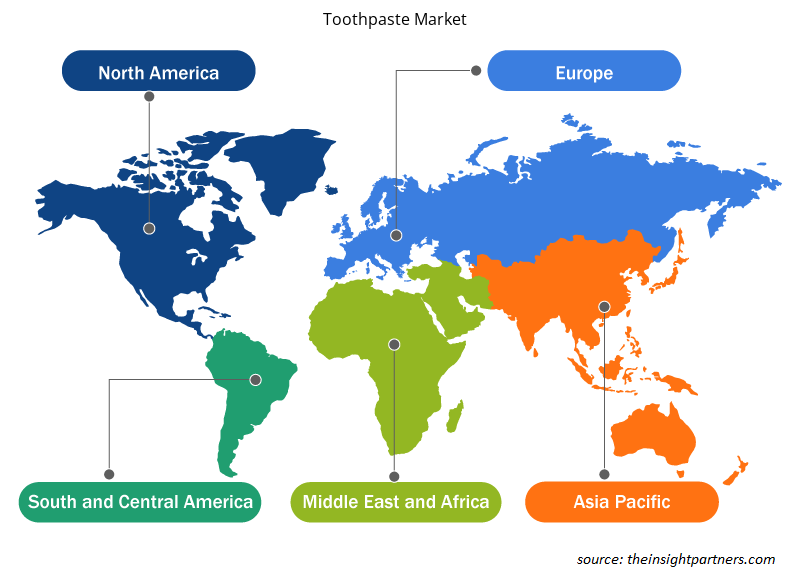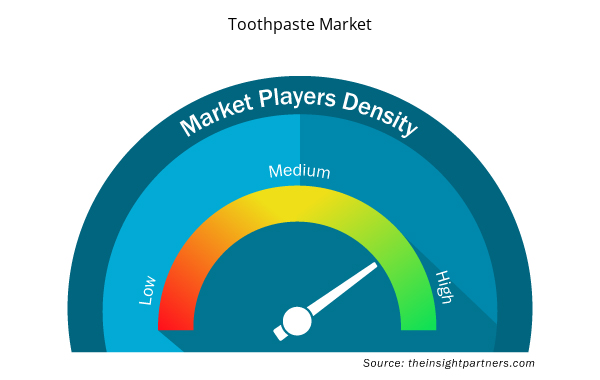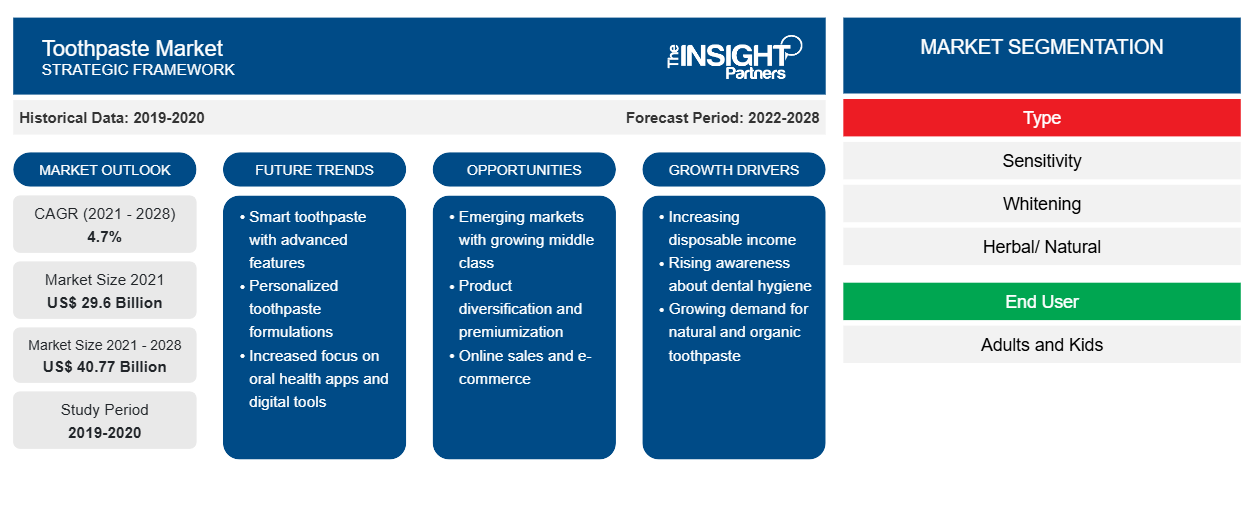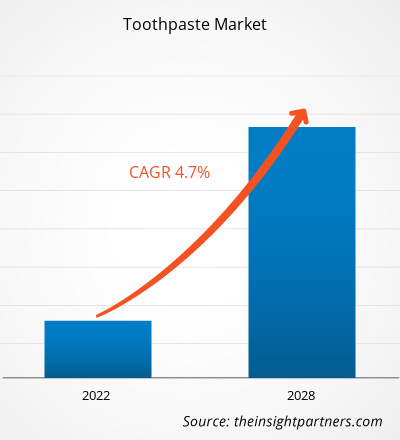[Forschungsbericht] Der Zahnpastamarkt wurde im Jahr 2021 auf 29.598,97 Millionen US-Dollar geschätzt und soll bis 2028 40.766,21 Millionen US-Dollar erreichen; es wird erwartet, dass er von 2021 bis 2028 mit einer durchschnittlichen jährlichen Wachstumsrate von 4,7 % wächst.
Mengenmäßig dürfte der weltweite Bedarf an Zahnpasta bis 2028 auf über 19 Milliarden Einheiten steigen.
Eine Zahnpasta besteht aus verschiedenen Bestandteilen. Die drei wichtigsten sind Schleifmittel, Fluorid und Reinigungsmittel. Zahnpasta dient der Mundhygiene: Sie ist ein Schleifmittel, das hilft, Plaque und Speisereste von den Zähnen zu entfernen, Mundgeruch zu unterdrücken und Wirkstoffe (meistens Fluorid) zur Behandlung von Karies und zur Vorbeugung von Zahnfleischerkrankungen enthält.
Im Jahr 2020 hatte der asiatisch-pazifische Raum den größten Anteil am weltweiten Zahnpastamarkt . Süd- und Mittelamerika werden im Prognosezeitraum voraussichtlich die höchste durchschnittliche jährliche Wachstumsrate verzeichnen. Der Zahnpastamarkt in der Region umfasst mehrere Volkswirtschaften wie Australien, Indien, China, Japan, Südkorea und den Rest des Asien-Pazifik-Raums . Die wichtigsten Faktoren, die den Zahnpastamarkt antreiben, sind eine starke Kundenbasis, ein gestiegenes Bewusstsein für Mundgesundheit und -hygiene sowie Veränderungen im Lebensstil. In Indien ist Zahnempfindlichkeit sehr verbreitet. In der Region besteht eine hohe Nachfrage nach bedarfsgerechten Angeboten wie Zahnpasta gegen Zahnempfindlichkeit, aufhellende Zahnpasta, Zahnpasta auf Gelbasis oder Zahnpasta mit pflanzlichen und natürlichen Inhaltsstoffen. Diese Zahnpastakategorien werden in den nächsten Jahren einen größeren Anteil erreichen. Es besteht eine hohe Nachfrage nach Zahnpasta mit unterschiedlichen Geschmacksrichtungen. Mit einer deutlichen Verschiebung der Verbrauchernachfrage nach natürlicher Zahnpasta wächst das natürliche und pflanzliche Untersegment des Zahnpastamarktes schneller.
Passen Sie diesen Bericht Ihren Anforderungen an
Sie erhalten kostenlos individuelle Anpassungen an jedem Bericht, einschließlich Teilen dieses Berichts oder einer Analyse auf Länderebene, eines Excel-Datenpakets sowie tolle Angebote und Rabatte für Start-ups und Universitäten.
- Holen Sie sich die wichtigsten Markttrends aus diesem Bericht.Dieses KOSTENLOSE Beispiel umfasst eine Datenanalyse von Markttrends bis hin zu Schätzungen und Prognosen.
Die COVID-19-Pandemie hat die gesamte Körperpflegebranche stark beeinträchtigt. Einzelhändler für Körperpflegeprodukte sind gezwungen, nur noch lebensnotwendige Produkte wie Lebensmittel, Getränke und Körperhygieneprodukte wie Zahnpasta, Desinfektionsmittel und Seifen zu priorisieren, während gleichzeitig die Sortimentsgrößen und Lagereinheiten ( SKUs ) anderer Produktkategorien wie Kräuterzahnpasta reduziert wurden. Der weltweite Lockdown aufgrund der COVID-19-Pandemie hat das Kaufverhalten der Verbraucher besonders beeinflusst, indem er deren Kaufgewohnheiten geprägt hat. Infolge des Ausbruchs verschiebt sich die Neigung der Verbraucher zu Hygieneprodukten. Darüber hinaus war die Tendenz der Verbraucher zu Produkten ohne Zusatzstoffe und giftige Chemikalien ein entscheidender Faktor, der die Nachfrage nach Kräuterzahnpastaprodukten während dieses Lockdowns ankurbelte . Aufgrund der mangelnden Verfügbarkeit von Kräuterzahnpastaprodukten im Einzelhandel neigen Verbraucher dazu, diese Produkte über E-Commerce-Kanäle zu erwerben. Der Produktmangel und die Logistikprobleme werden jedoch voraussichtlich zu einer Lücke zwischen Angebot und Nachfrage auf Online-Plattformen führen.
Markteinblicke
Zahnprobleme bei geriatrischen und pädiatrischen Patienten
Immer mehr Kinder haben Zahnprobleme, was das Marktwachstum voraussichtlich deutlich ankurbeln wird. Nach Angaben der Weltgesundheitsorganisation hatten im März 2020 weltweit fast 530 Millionen Kinder Karies an den Milchzähnen. Darüber hinaus erhöht das Wachstum der geriatrischen Bevölkerung die Nachfrage nach Zahnpasta, da diese Altersgruppe sehr anfällig für verschiedene Zahnprobleme wie Karies, Zahnfleischerkrankungen und Zahnfäule ist. Nach Angaben des US-Gesundheitsministeriums hat etwa 1 von 5 (20 %) Kindern im Alter von 5 bis 11 Jahren mindestens einen unbehandelten kariösen Zahn. Darüber hinaus hat 1 von 7 (13 %) Teenagern im Alter von 13 bis 19 Jahren mindestens einen unbehandelten kariösen Zahn. Außerdem hatten fast alle Erwachsenen (96 %) im Alter von 65 Jahren oder älter Karies; 1 von 5 hat unbehandelte Karies.
Typ-Einblicke
Der globale Zahnpastamarkt ist nach Typ in die Segmente Empfindlichkeit, Aufhellung, Kräuter/natürliche Produkte, Raucher und Medikamente unterteilt. Das Segment Aufhellung war 2020 der führende Zahnpastamarkt weltweit. Aufhellende Zahnpasta wird hergestellt, um die Zahnaufhellung zu fördern. Diese aufhellende Zahnpasta kann die Zähne leicht aufhellen, indem sie oberflächliche Flecken von den Zähnen entfernt. Um oberflächliche Flecken zu entfernen, enthält aufhellende Zahnpasta hauptsächlich spezielle Schleifpartikel oder Chemikalien, die die Zähne sanft polieren. Die ständig wachsende Nachfrage nach weißeren Zähnen hat zu einem Wachstum des Marktes für aufhellende Zahnpasta geführt. Zu den Marken, die aufhellende Zahnpasta anbieten, gehören Crest, Colgate, Toms of Maine und Arm & Hammer.
Zu den wichtigsten Marktteilnehmern auf dem Zahnpastamarkt zählen Procter & Gamble, Unilever, GlaxoSmithKline Plc ., Colgate-Palmolive Company, Henkel Ag & Company, KGAA , 3M, Sunstar Suisse S.A. , Lion Corporation, Beverly Glen Laboratories, Inc. und The Himalaya Drug Company.
Regionale Einblicke in den Zahnpastamarkt
Die regionalen Trends und Faktoren, die den Zahnpastamarkt im Prognosezeitraum beeinflussen, wurden von den Analysten von Insight Partners ausführlich erläutert. In diesem Abschnitt werden auch die Marktsegmente und die Geografie des Zahnpastamarkts in Nordamerika, Europa, im asiatisch-pazifischen Raum, im Nahen Osten und Afrika sowie in Süd- und Mittelamerika erörtert.

- Holen Sie sich regionale Daten zum Zahnpastamarkt
Umfang des Zahnpasta-Marktberichts
| Berichtsattribut | Details |
|---|---|
| Marktgröße im Jahr 2021 | 29,6 Milliarden US-Dollar |
| Marktgröße bis 2028 | 40,77 Milliarden US-Dollar |
| Globale CAGR (2021 - 2028) | 4,7 % |
| Historische Daten | 2019-2020 |
| Prognosezeitraum | 2022–2028 |
| Abgedeckte Segmente | Nach Typ
|
| Abgedeckte Regionen und Länder | Nordamerika
|
| Marktführer und wichtige Unternehmensprofile |
|
Dichte der Akteure auf dem Zahnpastamarkt: Die Auswirkungen auf die Geschäftsdynamik verstehen
Der Zahnpastamarkt wächst rasant, angetrieben durch die steigende Nachfrage der Endverbraucher aufgrund von Faktoren wie sich entwickelnden Verbraucherpräferenzen, technologischen Fortschritten und einem größeren Bewusstsein für die Vorteile des Produkts. Mit steigender Nachfrage erweitern Unternehmen ihr Angebot, entwickeln Innovationen, um die Bedürfnisse der Verbraucher zu erfüllen, und nutzen neue Trends, was das Marktwachstum weiter ankurbelt.
Die Marktteilnehmerdichte bezieht sich auf die Verteilung von Firmen oder Unternehmen, die in einem bestimmten Markt oder einer bestimmten Branche tätig sind. Sie gibt an, wie viele Wettbewerber (Marktteilnehmer) in einem bestimmten Marktraum im Verhältnis zu seiner Größe oder seinem gesamten Marktwert präsent sind.
Die wichtigsten auf dem Zahnpastamarkt tätigen Unternehmen sind:
- Procter & Gamble
- Unilever
- GlaxoSmithKline Plc.
- Colgate-Palmolive-Unternehmen
- Henkel Ag & Company, KGAA
Haftungsausschluss : Die oben aufgeführten Unternehmen sind nicht in einer bestimmten Reihenfolge aufgeführt.

- Überblick über die wichtigsten Akteure auf dem Zahnpastamarkt
Bericht-Spotlights
- Fortschrittliche Branchentrends auf dem globalen Zahnpastamarkt helfen den Akteuren bei der Entwicklung wirksamer langfristiger Strategien
- In Industrie- und Entwicklungsländern angewandte Strategien für Unternehmenswachstum
- Quantitative Analyse des globalen Zahnpastamarktes von 2019 bis 2028
- Schätzung der Nachfrage nach Zahnpasta in verschiedenen Branchen
- PEST-Analyse zur Veranschaulichung der Wirksamkeit der in der Branche tätigen Käufer und Lieferanten bei der Vorhersage des Marktwachstums
- Aktuelle Entwicklungen zum Verständnis der Wettbewerbssituation auf dem Markt und der Nachfrage nach Zahnpasta.
- Markttrends und -aussichten sowie Faktoren, die das Wachstum des Zahnpastamarktes vorantreiben und bremsen
- Entscheidungsprozess durch das Verständnis von Strategien, die das kommerzielle Interesse im Hinblick auf das Wachstum des globalen Zahnpastamarktes untermauern
- Die Größe des Zahnpastamarktes an verschiedenen Marktknoten
- Detaillierte Übersicht und Segmentierung des globalen Zahnpastamarktes sowie seiner Dynamik in der Branche
- Die Größe des Zahnpastamarktes in verschiedenen Regionen mit vielversprechenden Wachstumschancen
Der Bericht umfasst die Segmentierung des globalen Zahnpastamarktes wie folgt:
Nach Typ ist der globale Zahnpastamarkt in die Bereiche Empfindlichkeit, Aufhellung (Kariesschutz und andere), Kräuter/natürlich, Raucher und Medizinisch unterteilt. Nach Endverbraucher ist der Markt in Erwachsene und Kinder unterteilt. Nach Basistyp ist der Markt in Gel-basiert und Nicht-Gel-basiert unterteilt. Nach Vertriebskanal ist der Markt in Supermärkte und Hypermärkte, Convenience Stores, Online-Einzelhandel und Drogerien/Apotheken unterteilt. Geografisch ist der Zahnpastamarkt grob in Nordamerika, Europa, Asien-Pazifik (APAC), Naher Osten und Afrika (MEA) sowie Süd- und Mittelamerika unterteilt. Der Markt in Nordamerika ist weiter in die USA, Kanada und Mexiko unterteilt. Der Zahnpastamarkt in Europa ist weiter in Deutschland, Frankreich, Großbritannien, Italien, Russland und den Rest von Europa unterteilt. Der Markt im Asien-Pazifik-Raum ist weiter in China, Indien, Japan, Australien, Südkorea und den Rest des Asien-Pazifik-Raums unterteilt. Der Zahnpastamarkt im Nahen Osten und Afrika (MEA) ist weiter segmentiert in Südafrika, Saudi-Arabien, die Vereinigten Arabischen Emirate und den Rest von MEA. Der Markt in Süd- und Mittelamerika ist weiter segmentiert in Brasilien, Argentinien, Chile, Kolumbien und den Rest von Süd- und Mittelamerika.
Firmenprofile
- 3M
- Procter & Gamble
- Unilever
- GlaxoSmithKline Plc.
- Colgate-Palmolive-Unternehmen
- Henkel Ag & Company KGAA
- Sunstar Suisse SA
- Lion Corporation
- Beverly Glen Laboratories, Inc.
- Die Himalaya Drug Company
- Historische Analyse (2 Jahre), Basisjahr, Prognose (7 Jahre) mit CAGR
- PEST- und SWOT-Analyse
- Marktgröße Wert/Volumen – Global, Regional, Land
- Branche und Wettbewerbsumfeld
- Excel-Datensatz



Report Coverage
Revenue forecast, Company Analysis, Industry landscape, Growth factors, and Trends

Segment Covered
This text is related
to segments covered.

Regional Scope
North America, Europe, Asia Pacific, Middle East & Africa, South & Central America

Country Scope
This text is related
to country scope.
Häufig gestellte Fragen
Kids segment is expected to witness tremendous growth over the forecast period. Increasing awareness about the harmful effects of fluoride on kids’ health is a major factor fueling the demand for kids’ toothpaste. Moreover, increasing product offerings by the major manufacturers are expected to further aid the growth of the kids segment.
Toothpaste is expected to witness significant growth and innovation in the coming years. Sustainability is expected to be a key differentiating factor in the future among the toothpaste manufacturers. A 2020 Study from Shorr Packaging found that two-thirds of shoppers who have made changes in their purchasing behaviors during the pandemic are certainly paying more attention to packaging. Also, 58% of survey respondents reported being "likely" to select products that use reusable or recyclable packaging. Many manufacturers such as Unilever have also committed use packaging that are sustainable for their toothpaste brands.
Asia Pacific accounted for the largest share of the global toothpaste market. Factors such as a strong customer base, growing consciousness about oral health, hygiene, and changing lifestyles are among the major factors driving the growth of the toothpaste market. In the region, there is a high demand for need-based offerings, which include toothpaste addressing tooth sensitivity, whitening, gel-based, or with herbal and natural ingredients.
The major players operating in the global toothpaste market are Procter & Gamble, Unilever, GlaxoSmithKline Plc., Colgate-Palmolive Company, Henkel Ag & Company, KGAA, 3M, Sunstar Suisse S.A., Lion Corporation, Beverly Glen Laboratories, Inc., and The Himalaya Drug Company among many others.
Toothpaste is an essential product that is available in the form of a white paste or colored gel. Toothpastes are derived from a variety of components, the three main ones being abrasives, fluoride, and detergents. Based on type, the market is segmented into Sensitivity, Whitening, Herbal/Natural, Smokers, and Medicated. Based on end-user, the market is segmented into adults, and kids. On the basis of base type, the market is segmented into gel-based and non-gel-based. Distribution channel segmentation includes supermarkets and hypermarkets, convenience stores, online retail, and drug stores/pharmacies.
The herbal or natural toothpaste contains herbal extracts and natural ingredients. No chemicals are added to them. The herbal or natural toothpaste market is growing at a faster rate, due to a shift in consumer demand for herbal or natural toothpaste with consumers increasingly seeking natural value-added remedies for their oral hygiene needs.
Trends and growth analysis reports related to Consumer Goods : READ MORE..
The List of Companies - Toothpaste Market
- Procter & Gamble
- Unilever
- GlaxoSmithKline Plc.
- Colgate-Palmolive Company
- Henkel Ag & Company, KGAA
- 3M
- Sunstar Suisse S.A.
- Lion Corporation
- Beverly Glen Laboratories, Inc.
- The Himalaya Drug Company
The Insight Partners performs research in 4 major stages: Data Collection & Secondary Research, Primary Research, Data Analysis and Data Triangulation & Final Review.
- Data Collection and Secondary Research:
As a market research and consulting firm operating from a decade, we have published and advised several client across the globe. First step for any study will start with an assessment of currently available data and insights from existing reports. Further, historical and current market information is collected from Investor Presentations, Annual Reports, SEC Filings, etc., and other information related to company’s performance and market positioning are gathered from Paid Databases (Factiva, Hoovers, and Reuters) and various other publications available in public domain.
Several associations trade associates, technical forums, institutes, societies and organization are accessed to gain technical as well as market related insights through their publications such as research papers, blogs and press releases related to the studies are referred to get cues about the market. Further, white papers, journals, magazines, and other news articles published in last 3 years are scrutinized and analyzed to understand the current market trends.
- Primary Research:
The primarily interview analysis comprise of data obtained from industry participants interview and answers to survey questions gathered by in-house primary team.
For primary research, interviews are conducted with industry experts/CEOs/Marketing Managers/VPs/Subject Matter Experts from both demand and supply side to get a 360-degree view of the market. The primary team conducts several interviews based on the complexity of the markets to understand the various market trends and dynamics which makes research more credible and precise.
A typical research interview fulfils the following functions:
- Provides first-hand information on the market size, market trends, growth trends, competitive landscape, and outlook
- Validates and strengthens in-house secondary research findings
- Develops the analysis team’s expertise and market understanding
Primary research involves email interactions and telephone interviews for each market, category, segment, and sub-segment across geographies. The participants who typically take part in such a process include, but are not limited to:
- Industry participants: VPs, business development managers, market intelligence managers and national sales managers
- Outside experts: Valuation experts, research analysts and key opinion leaders specializing in the electronics and semiconductor industry.
Below is the breakup of our primary respondents by company, designation, and region:

Once we receive the confirmation from primary research sources or primary respondents, we finalize the base year market estimation and forecast the data as per the macroeconomic and microeconomic factors assessed during data collection.
- Data Analysis:
Once data is validated through both secondary as well as primary respondents, we finalize the market estimations by hypothesis formulation and factor analysis at regional and country level.
- Macro-Economic Factor Analysis:
We analyse macroeconomic indicators such the gross domestic product (GDP), increase in the demand for goods and services across industries, technological advancement, regional economic growth, governmental policies, the influence of COVID-19, PEST analysis, and other aspects. This analysis aids in setting benchmarks for various nations/regions and approximating market splits. Additionally, the general trend of the aforementioned components aid in determining the market's development possibilities.
- Country Level Data:
Various factors that are especially aligned to the country are taken into account to determine the market size for a certain area and country, including the presence of vendors, such as headquarters and offices, the country's GDP, demand patterns, and industry growth. To comprehend the market dynamics for the nation, a number of growth variables, inhibitors, application areas, and current market trends are researched. The aforementioned elements aid in determining the country's overall market's growth potential.
- Company Profile:
The “Table of Contents” is formulated by listing and analyzing more than 25 - 30 companies operating in the market ecosystem across geographies. However, we profile only 10 companies as a standard practice in our syndicate reports. These 10 companies comprise leading, emerging, and regional players. Nonetheless, our analysis is not restricted to the 10 listed companies, we also analyze other companies present in the market to develop a holistic view and understand the prevailing trends. The “Company Profiles” section in the report covers key facts, business description, products & services, financial information, SWOT analysis, and key developments. The financial information presented is extracted from the annual reports and official documents of the publicly listed companies. Upon collecting the information for the sections of respective companies, we verify them via various primary sources and then compile the data in respective company profiles. The company level information helps us in deriving the base number as well as in forecasting the market size.
- Developing Base Number:
Aggregation of sales statistics (2020-2022) and macro-economic factor, and other secondary and primary research insights are utilized to arrive at base number and related market shares for 2022. The data gaps are identified in this step and relevant market data is analyzed, collected from paid primary interviews or databases. On finalizing the base year market size, forecasts are developed on the basis of macro-economic, industry and market growth factors and company level analysis.
- Data Triangulation and Final Review:
The market findings and base year market size calculations are validated from supply as well as demand side. Demand side validations are based on macro-economic factor analysis and benchmarks for respective regions and countries. In case of supply side validations, revenues of major companies are estimated (in case not available) based on industry benchmark, approximate number of employees, product portfolio, and primary interviews revenues are gathered. Further revenue from target product/service segment is assessed to avoid overshooting of market statistics. In case of heavy deviations between supply and demand side values, all thes steps are repeated to achieve synchronization.
We follow an iterative model, wherein we share our research findings with Subject Matter Experts (SME’s) and Key Opinion Leaders (KOLs) until consensus view of the market is not formulated – this model negates any drastic deviation in the opinions of experts. Only validated and universally acceptable research findings are quoted in our reports.
We have important check points that we use to validate our research findings – which we call – data triangulation, where we validate the information, we generate from secondary sources with primary interviews and then we re-validate with our internal data bases and Subject matter experts. This comprehensive model enables us to deliver high quality, reliable data in shortest possible time.


 Holen Sie sich ein kostenloses Muster für diesen Bericht
Holen Sie sich ein kostenloses Muster für diesen Bericht